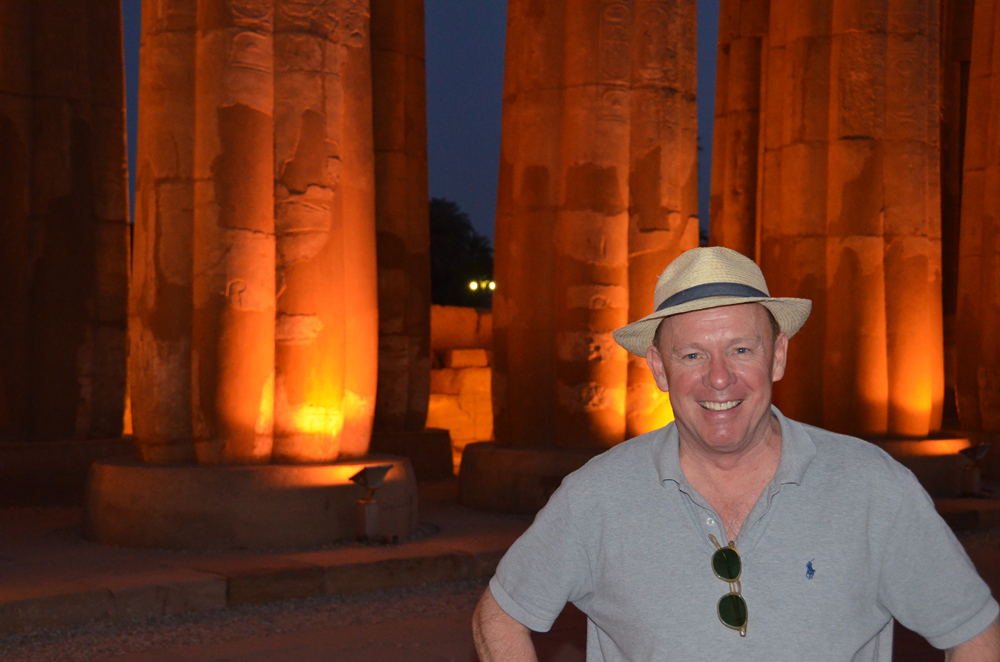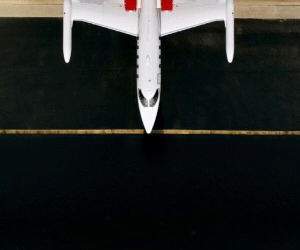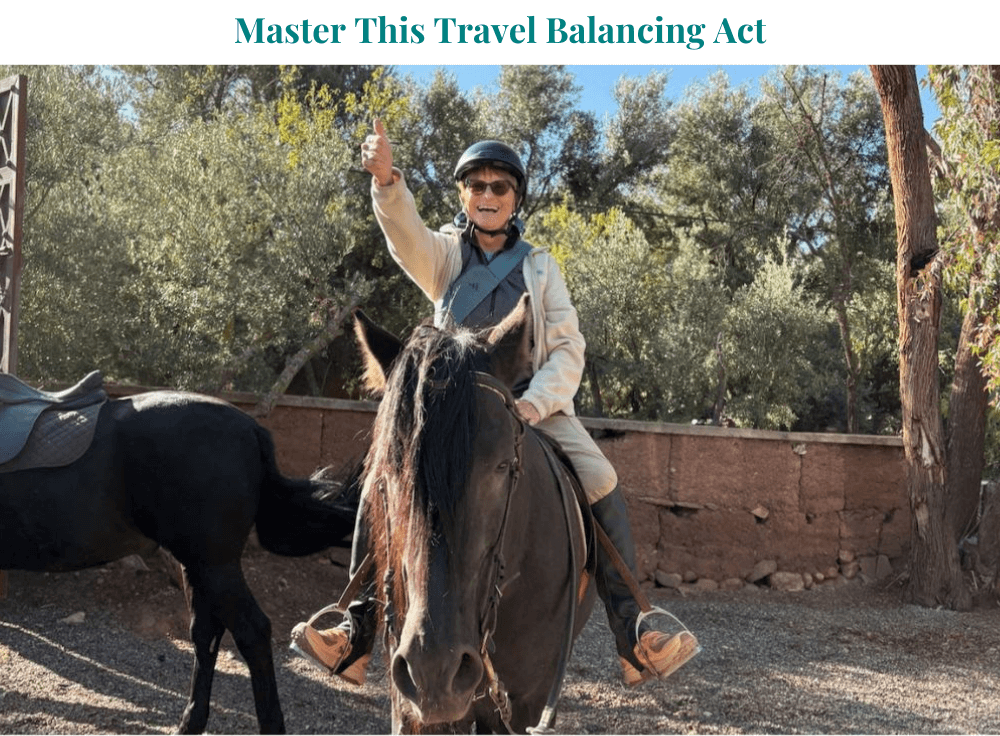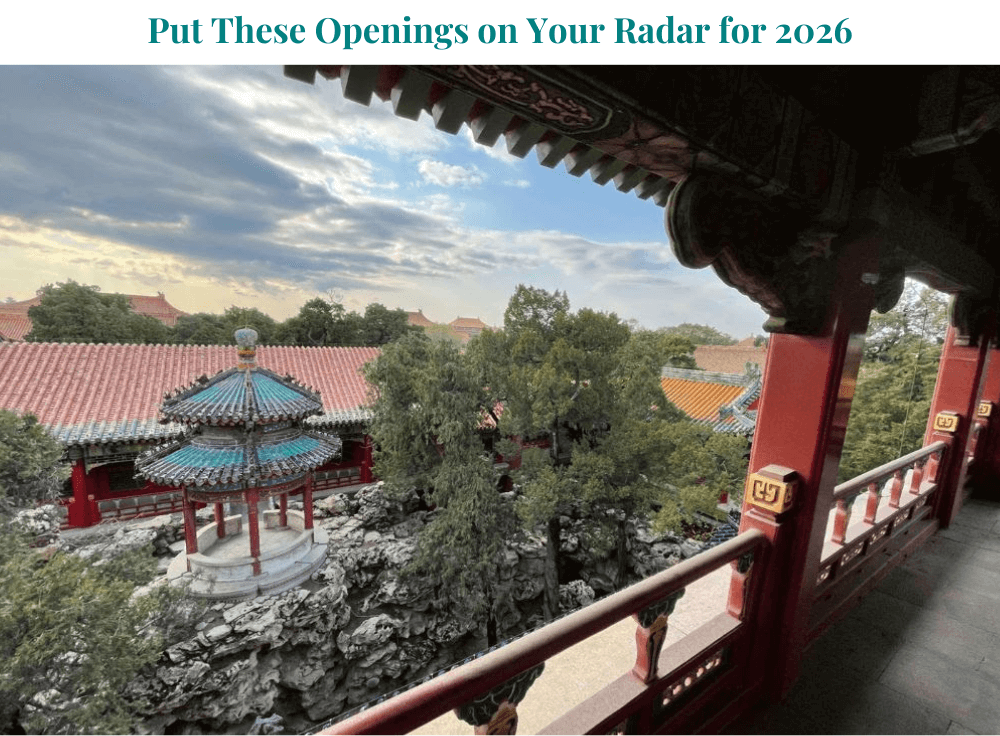Egypt: Insider’s Guide
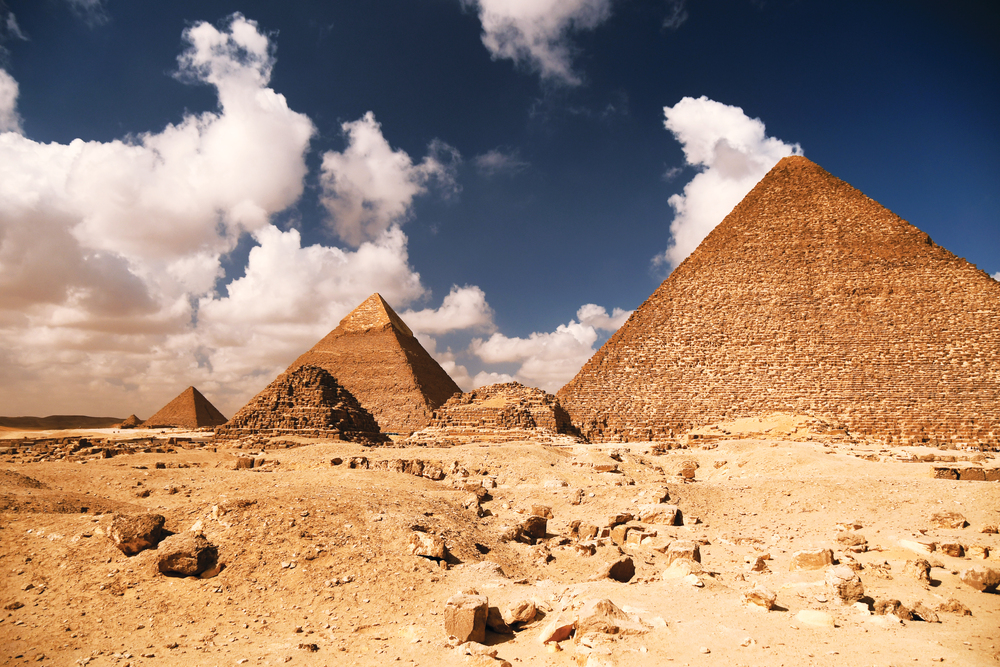 Read on to learn how to have a private experience of the Pyramids of Giza. Photo: Jim Berkeley
Read on to learn how to have a private experience of the Pyramids of Giza. Photo: Jim Berkeley
The insider advice on this page is from one of Wendy’s Trusted Travel Experts for Egypt: Jim Berkeley of DAI Travel.
Jim jokes that he’s a frustrated Indiana Jones—which is why he’s spent much of his career scrambling around the ancient temples and pyramids of Egypt. After five years in Cairo running the local office of a major travel firm, he started his own company in 1995 to plan trips to Egypt and beyond. Jim’s customized itineraries combine luxury and adventure—he’ll have you sailing down the Nile in a dahabiya one day and lounging by the pool at the Old Cataract Hotel the next—and he has the connections to get you into tombs that are closed to the public. Most important, Jim and his team are meticulous about keeping their travelers socially distanced and out of harm’s way. If you want to combine your time in Egypt with a stop in Jordan or Israel, Jim can make it happen in the smartest possible way.
Where to Stay and Eat
Best bang-for-your-buck hotels
In Cairo: Situated directly on the Nile in the affluent Garden City neighborhood, the Kempinski Nile Cairo offers guests a prime location at an affordable price. If that weren’t enough to convince you, the Kempinski also hosts an excellent restaurant, Osmanly, a jazz bar offering live music with a Nile view, and a luxurious spa.
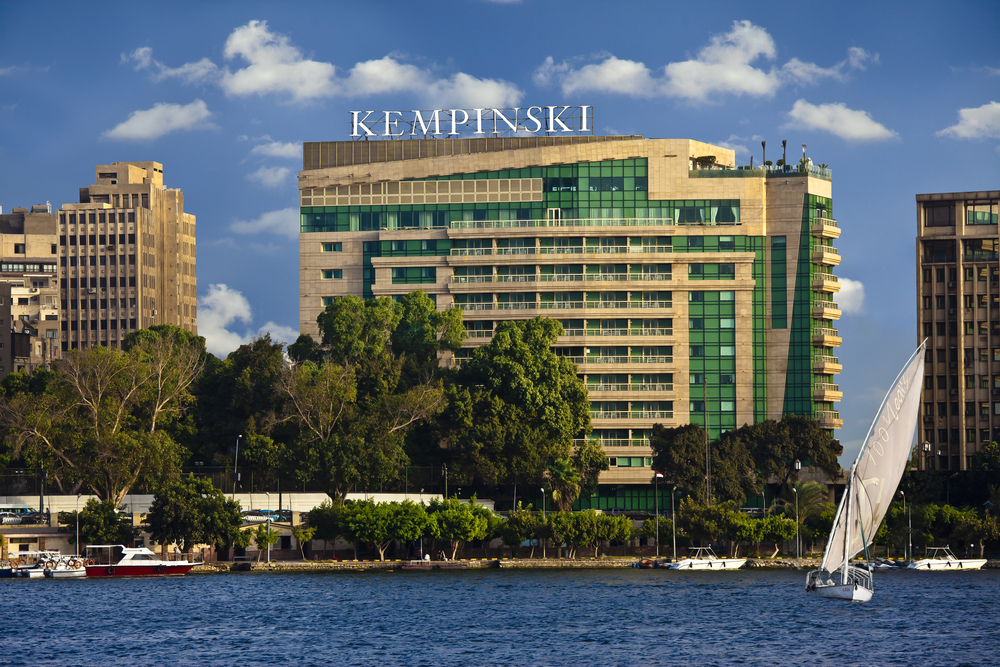
Enjoy Nile views from the Kempinski in Cairo. Photo: Kempinski Nile Hotel
In the countryside: Adrere Amellal Eco-Lodge in Siwa Oasis is a total sybaritic pleasure, and also a fascinating porthole into the nomadic desert life. Siwa is an eight-hour drive from Cairo, but Jim sends an Egyptologist along with his travelers to make the journey part of the experience. The setting, under Adrere Amellal (the White Mountain) on the banks of a saline lake, is divine. The resort is built from local materials—mud bricks, thatch, palm branches, and the like. There is no electricity. The organic garden provides the basis for incredible cuisine, and the desert excursions into the Great Sand Sea are awesome. Jim’s travelers get guaranteed upgrades.
Best-value splurge hotels
In Luxor: Intimate, tranquil, and sophisticated, Hotel Al Moudira offers 54 spacious suites grouped around a series of lushly landscaped private courtyards. Each suite is unique, featuring antique furnishings, high domed ceilings, hand-painted frescoes, and king-sized beds dressed with, of course, fine Egyptian cotton. The restaurant’s imaginative fusion menu makes use of seasonal local and organic ingredients. Al Moudira is the first hotel in Egypt to become a member of the Relais & Châteaux group.
In Aswan: The Sofitel Legend Old Cataract is legendary—full stop. If you are going to splurge on one hotel room in Egypt, this is the place to do it. On the banks of the Nile, the hotel sits atop a granite cliff at the location of the river’s first cataract. Built in 1902 by the British, the hotel oozes history and its guest book is a who’s who of royals, dignitaries, and stars. While some may prefer a suite in the Palace wing, Jim likes the Nile-view rooms best.
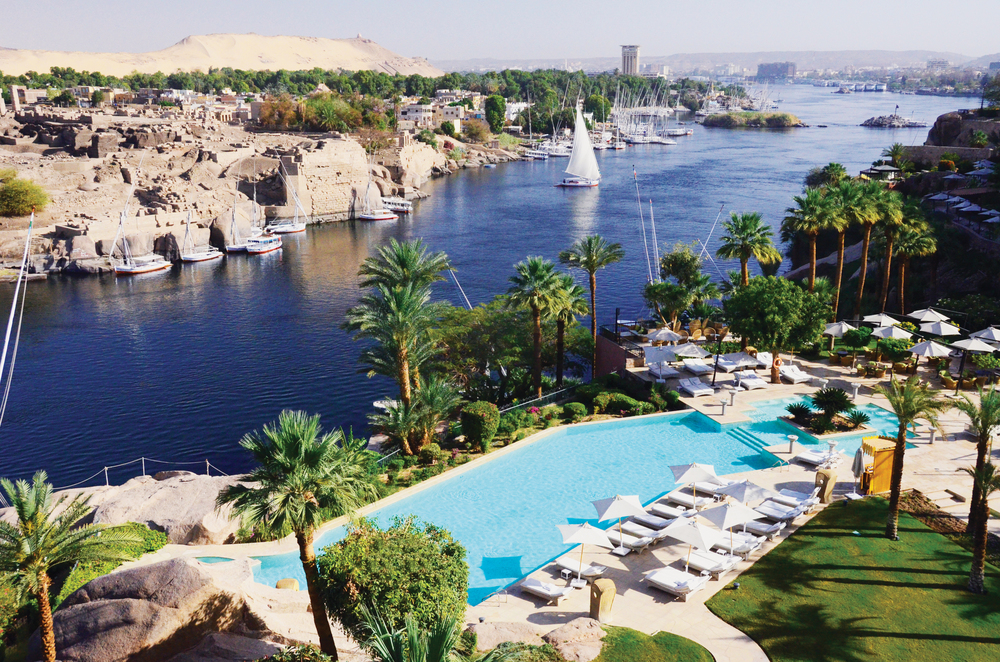
The rocks beside the Old Cataract’s pool show the marks of ancient stonecutters. Photo: Jim Berkeley
Restaurants the locals love
In Cairo’s Khan el Khalili Bazaar, the historic Khan el Khalili Restaurant & Nagiub Mahfouz Café provides a welcome respite from the crowds and heat, offering up excellent renditions of Egypt’s most famous dishes.
Located on Zamalek, an island in the Nile, Abou el Sid serves up Egyptian classics as well as Ottoman- and Levantine-inspired dishes. Its welcoming ambiance and traditional décor make it a popular choice among both locals and visitors to Cairo.
Sofra, near the Luxor Temple, specializes in traditional Egyptian cuisine. Its peaceful atmosphere, rooftop terrace, and traditional décor make it a perfect lunch spot while touring, though it’s also great at dinner. Note: It’s cash only.
For a relaxing dinner after a long day of temple and tomb viewing, choose the Garden at Al Marsam. Hidden deep in the sugar cane fields of the West Bank of ancient Thebes, Al Marsam serves the traditional cuisine of Upper Egypt in a peaceful, tree-filled courtyard. The menu changes daily, the ingredients are locally sourced, and much of the produce is organic and grown on site.
Dishes to try
Om Ali, a delicious dessert. There are several legends about the origin of the dessert, the most popular being that Om Ali, the first wife of the sultan Ezz El Din Aybek, made the confection to celebrate the death of the sultan’s second wife (which Om Ali may have had something do with). The story aside, it’s a divine treat. Made from puff pastry, milk, sugar, raisins, flaked coconut, pistachios, cinnamon, and whipping cream, how could it be anything but fabulous? Try it at one of the El Malky dessert shops in Cairo.
Kofta, a combination of ground beef, ground lamb, and spices formed into a sausage-shaped patty, then grilled over sizzling charcoal. It’s served with the typical Egyptian mezzes of hummus, tahine, baladi bread, and tabouleh; in Cairo, El Dahan, Abou Shakra, and Zein el Abdin Abu Ramy (opposite the Children’s Cancer Center) all make particularly good versions.
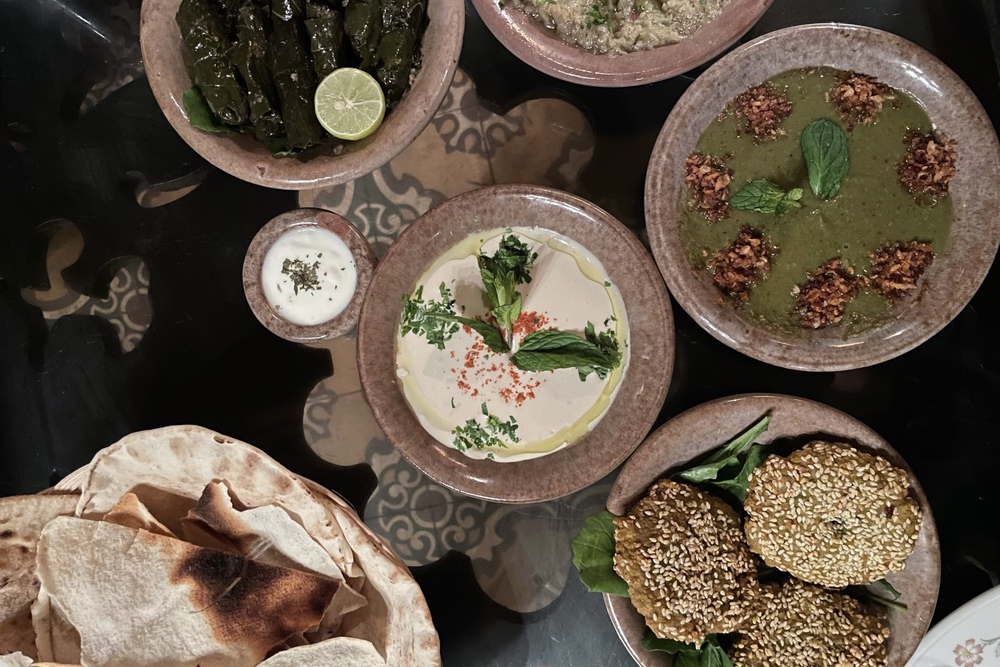
A typical mezze spread of traditional Egyptian dishes, including hummus and falafel. Photo: Jim Berkeley
Meals worth the splurge
For Asian flavors and a chic fine-dining experience in Cairo, look no further than Sachi Heliopolis, which was voted best restaurant in Egypt by “The World’s 50 Best Restaurants” in 2022.
The 1902 Restaurant at the Old Cataract Hotel in Aswan. This incredible room, with its Moorish decor and 125-foot Arabian dome, served as the Grand Ballroom in the movie version of Agatha Christie’s Death on the Nile. Dress for the occasion and treat yourself to one spectacular evening of French cuisine and unforgettable ambiance.
Cruise past Elephantine and Lord Kitchener’s Islands as you dine aboard a private yacht in Aswan. Jim can arrange a night cruise on the Nile just for you. Kick back with cocktails as your personal chef prepares dinner, paired with excellent local wines. Time to celebrate? The yacht can accommodate up to 10 guests for a meal.
Instagram moment
Get up early and head to the Sphinx as soon as the Giza Pyramids open at 8 a.m. Make a beeline through the Valley Temple and up the ramp before anyone else is there. With the sun rising in the east and creating a warm, luminescent glow on the face of the Sphinx, get ready to take the best possible photo of this iconic creature—with the Pyramids in the background to boot!
What to See and Do
Most anticipated opening
The Grand Egyptian Museum (GEM) has been under construction for 20 years. The museum’s vast halls will hold tens of thousands of artifacts, including the first exhibition of the full collection from King Tut’s tomb. Though the official opening date is still unknown, Jim can organize a private visit after working hours or a behind-the-scenes tour, which includes a visit to the Conservation Center and lunch. Such experiences are understandably pricey; for those on a more moderate budget, Jim can get you into the Grand Hall and Grand Staircase Gallery, which holds over 60 historically significant artifacts—royal statues and stelae, towering columns and sarcophagi.
Don’t miss
The Oases of the Western Desert. This underdeveloped and under-visited part of Egypt is waiting to be discovered. From the Valley of the Golden Mummies and the hidden tombs in Bahariya, to the amazing White Desert near Farafra, to Alexander’s Temple and giant dunes of the Great Sand Sea near Siwa Oasis, there are spectacular things to see and do here. Further south, near Abu Mingur and Dakhla, are Roman-era ruins and the Ptolemaic Temple of Hibis at Kharga. With the opening of the vibrant boutique Lazib Inn Resort & Spa in Fayoum Oasis’ Tunis village, travelers now have a luxurious base from which to explore the beautiful scenery of the Western Desert and bird-watch at the same time.
In Cairo: Located in the Khan el Khalili Bazaar, El-Moaz Street is one of the best medieval architectural treasures in the Islamic world. Dating back to the Fatimid era (tenth century B.C.), it features myriad types of Islamic architecture decorated with beautiful Arabic calligraphy. A stroll along this street, coupled with coffee or tea at nearby El-Fishawy, makes for the perfect day. Also in Cairo, be sure to visit the National Museum of Egyptian Civilization, the new home of Egypt’s Royal Mummies (see below).
In Luxor: The Karnak Open-Air Museum. Adjacent to magnificent Karnak Temple sits this hidden treasure. The Karnak Temple was built over a period of perhaps 1,000 years, spanning the reigns of numerous pharaohs—many of whom tore down the work of their predecessor and used the materials for their own designs. In the ongoing archaeological projects at Karnak, these hidden treasures have been painstakingly reassembled, including the Red Chapel of Queen Hatchepsut, the White Temple of Senusret I, and the calcite shrine of Amenhotep II. Almost everyone who visits Karnak just walks right by the Open-Air Museum, so you will have the site to yourselves.
In Sakkara: The tunnel under the step pyramid leading to the burial chamber of King Djoser 90 feet below is newly accessible to visitors. The tomb of Mehu was recently opened and features colorful and exquisite reliefs, including untouched painted hieroglyphic inscriptions dating back 4,400 years. The Serapeum was recently reopened after a thorough renovation; the tombs of the Apis Bulls and the massive sarcophagi make for a surreal visit. And the pyramid of Unas boasts the finest example of the Pyramid Texts on its ceiling.
Don’t bother
In Cairo, the Pharaonic Village is a tacky representation of ancient Egypt, replete with bored actors, fake costumes, and inaccuracies.
In Luxor, the bogus Mummification Museum is not a museum at all but a commercial enterprise. For the real deal, go to the Royal Mummies Room in Cairo’s National Museum of Egyptian Civilizations. You’ll get to see the amazingly well-preserved mummy of Pharaoh Ramses the Great, builder of Abu Simbel, the Ramasseum, and many of Egypt’s iconic temples. Ramses’ slightly reddish hair is still intact, his patrician hooked nose is still imposing, and his fingers and toenails are surprisingly well groomed. The mummy of Taa II, also on display, clearly shows that he died in battle, given the massive gash in his skull (probably from a war ax). The museum also provides a dazzling overview of Egypt’s entire civilization development from pre-historic times to current day.
Most underrated experience
Take a culinary walking tour through Old Cairo. You’ll try a different bite of Egyptian food at each stop, and learn fascinating bits of history and contemporary culture from your guide along the way.
Hidden gem
Spend an afternoon at the Kalabsha Island Temple Complex, located in the Nubian Sea (Lake Nasser) above the Aswan High Dam. Kalabsha Island is home to four separate temples: First, visit the Temple of Kalabsha (or Temple of Mandulis), built in the Roman period during the reign of Emperor Augustus. Next, see the Temple of Gerf Hussein, originally known as the House of Ptah, which is dedicated to Ramses II. Take in rock-cut temple Beit el-Wali, built during the reign of Ramses II and dedicated to the gods Amun and Anubis. Finally, admire the small but elegant Kiosk of Qertassi.
Cheap thrills
Luxor Temple at sunset. For the mere cost of an entrance ticket (less than $7 per person), go to the magnificent Luxor Temple just before sundown and first watch the site bask in the last rays as the sun sets over the Nile. (You won’t be alone, but the Egyptologist Jim can hire to accompany you will show you some interesting surprises off in the corners.) After dark, the temple is lit in various hues, from red to orange to white, illuminating the statuary and giant columns in a panoply of colors.
Anyone in Cairo will tell you that Abou Tarek restaurant serves the best khoshary at the best price (less than $5). Since 1950, Abou Tarek has been serving this traditional hearty dish of rice, macaroni, and chickpeas doused in a delicious tomato sauce and garlic juice.
Bragging rights
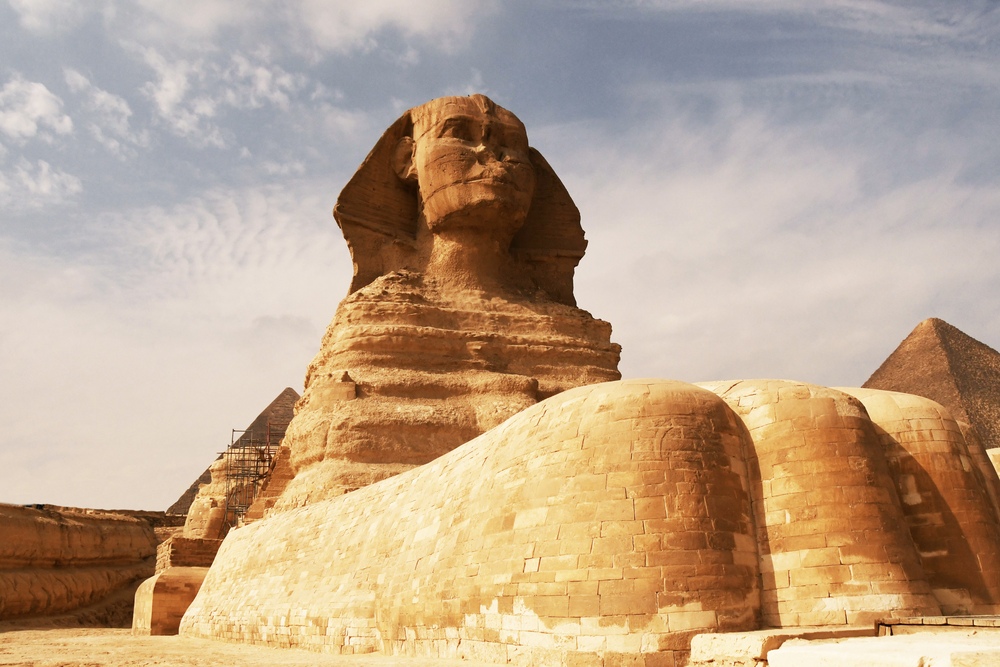
With the proper connections, you can view the Sphinx from ground level. Photo: Jim Berkeley
Gain special access to the Sphinx Paws in Giza with an Egyptologist. The Sphinx is one of the world’s most recognizable icons, and most people see it from above by walking around the edge of the old quarry in which it sits (and where the ancient Egyptians cut much of the stone used in the Pyramids). But to see the Sphinx from ground level inside the quarry, to walk between its giant paws, you need special access—which Jim can procure. From this vantage point, you can easily see that the Sphinx was not assembled piece by piece, but was carved from a single mass of limestone exposed when workers dug this horseshoe-shaped quarry in the Giza Plateau. You can also walk right up to the Dream Stele of Pharaoh Thutmose IV, right between the paws.
Enjoy dinner under the stars beside the Giza Pyramids. It’s not cheap, but Jim can arrange your very own multi-course private meal at this iconic site.
Or how about a private, after-hours visit and sit-down dinner at Luxor Temple? Jim can arrange that, as well as after-hours visits to Karnak Temple, Queen Hatchepsut’s Temple, and Medinat Habu Temple.
Best Times to Go
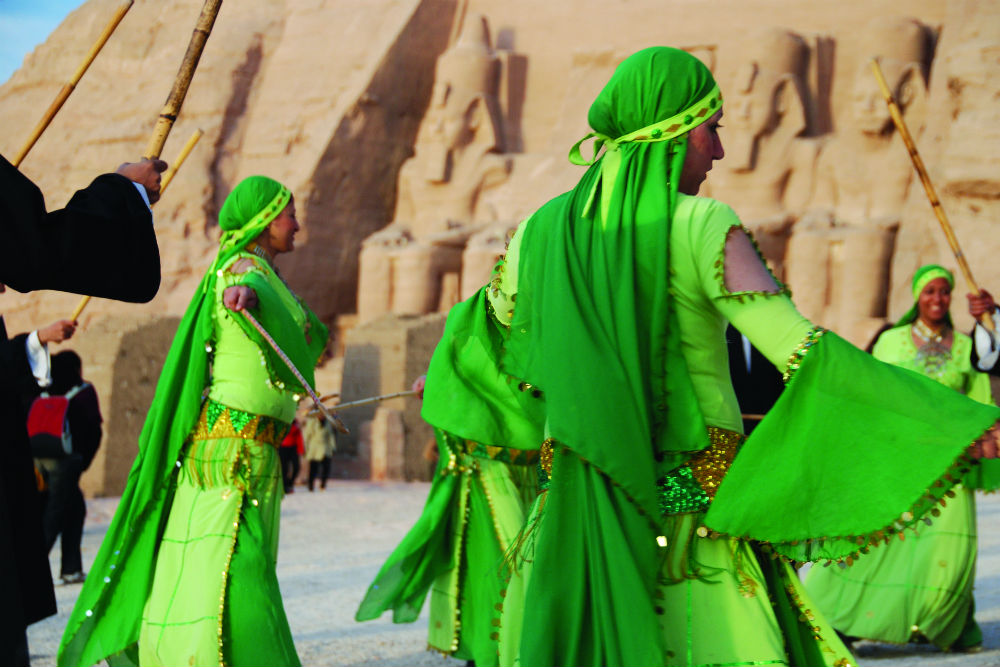
October and November. Temperatures are moderate around Cairo—typically in the 80s—and the heat is tolerable in Upper Egypt (an ancient term for the area around the Nile in the middle of the country; it is upriver from Cairo, since the river flows north). The air is clear and dry, making it the perfect time for photography, especially in the early morning when the sun’s rays highlight the rich hues of the temples and monuments, and at sunset, when the fading light always gives a lovely red glow to images.
Early December and late January. Days are warm, evenings are cool, and tourists are few.
May and June. Yes, it does start to get hotter during these months (around 90 in Cairo), but rates are at their lowest; if you can handle the heat, the cost savings are significant.
Worst Times to Go
July through September is the hottest time of year, with temperatures reaching triple digits.
The weeks around the Christmas and New Year’s holidays bring crowds and high prices—avoid them if you can.
Avoid traveling during Ramadan (dates vary, since it follows the lunar calendar), as everything closes early so that Muslims can get home to break their daily fast.
Biggest Rookie Mistake
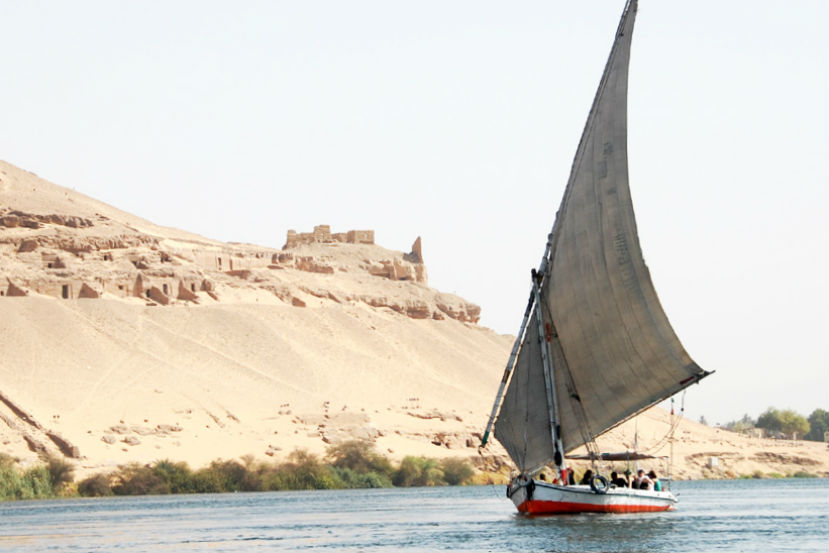
Thinking you can take a felucca on the Nile between Aswan and Luxor. A felucca is a traditional small wooden sailing boat with one lateen sail—very basic, no bathroom or sleeping quarters. You might in fact be able to find a felucca that will take you from Aswan to Luxor, but you certainly wouldn’t find it a comfortable trip! It’s very easy to get caught up in the romance of Agatha Christie staying at the Old Winter Palace Hotel in Luxor while writing her famous novel Death on the Nile, and then sailing off into the sunset on the Nile for Aswan. Who wouldn’t want to do that? Well, you can—but only on a dahabeyah and NOT a felucca. A dahabeyah is a shallow-bottomed, barge-like boat with two sails, sleeping quarters, and private facilities. If you want to take in the romance of a Nile cruise, then arrange to do that on a proper dahabeyah.
Scam Alert
At the Giza Pyramids, the scam goes like this: “Camel ride, camel ride? No! Camel photo, camel photo? No! Just one picture with my camel for free? No! You want to get up on my camel for free?” Finally you relent, because really you do want to get up on the camel’s back. For goodness’ sake, everyone wants to have a picture seated on a camel with the Pyramids in the background. So up you go, and you are happy for the moment. Then the camel driver says, “Twenty dollars to get down from the camel!”
Airport Intel
Spend the $75 per person and get a private transfer to Cairo International Airport for your departure from the country (you can do so through your hotel’s concierge). Your minder will deliver you to the check-in desk in an unruffled fashion, expedite your luggage check, fill out any customs and immigration forms required, and have you on your way in short order. Few foreigners are prepared to manage the controlled chaos that is Cairo’s airport on their own.
Tipping Tip
Here, the term is baksheesh, literally meaning a small sum of money given as alms, a tip, or even a bribe. It really doesn’t matter whether you give one dollar or ten Egyptian pounds (20 cents); the courteous thing is to extend a thought of kindness to whomever is providing you a service. Get some local currency in small bills, and just dole them out as required. At the end of the day, you will have given away little money but earned much goodwill.
It is common courtesy in Egypt to tip the bathroom attendant. Anything from ten Egyptian pounds to U.S. $1 per person is considered appropriate—and a small price to pay for a clean bathroom.
Don’t Forget to Pack
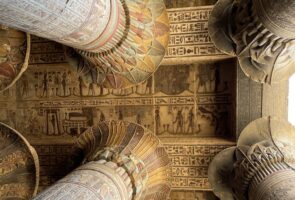
A bright, sturdy, small flashlight for illuminating the dark corners of the spectacular tombs you will be visiting.

